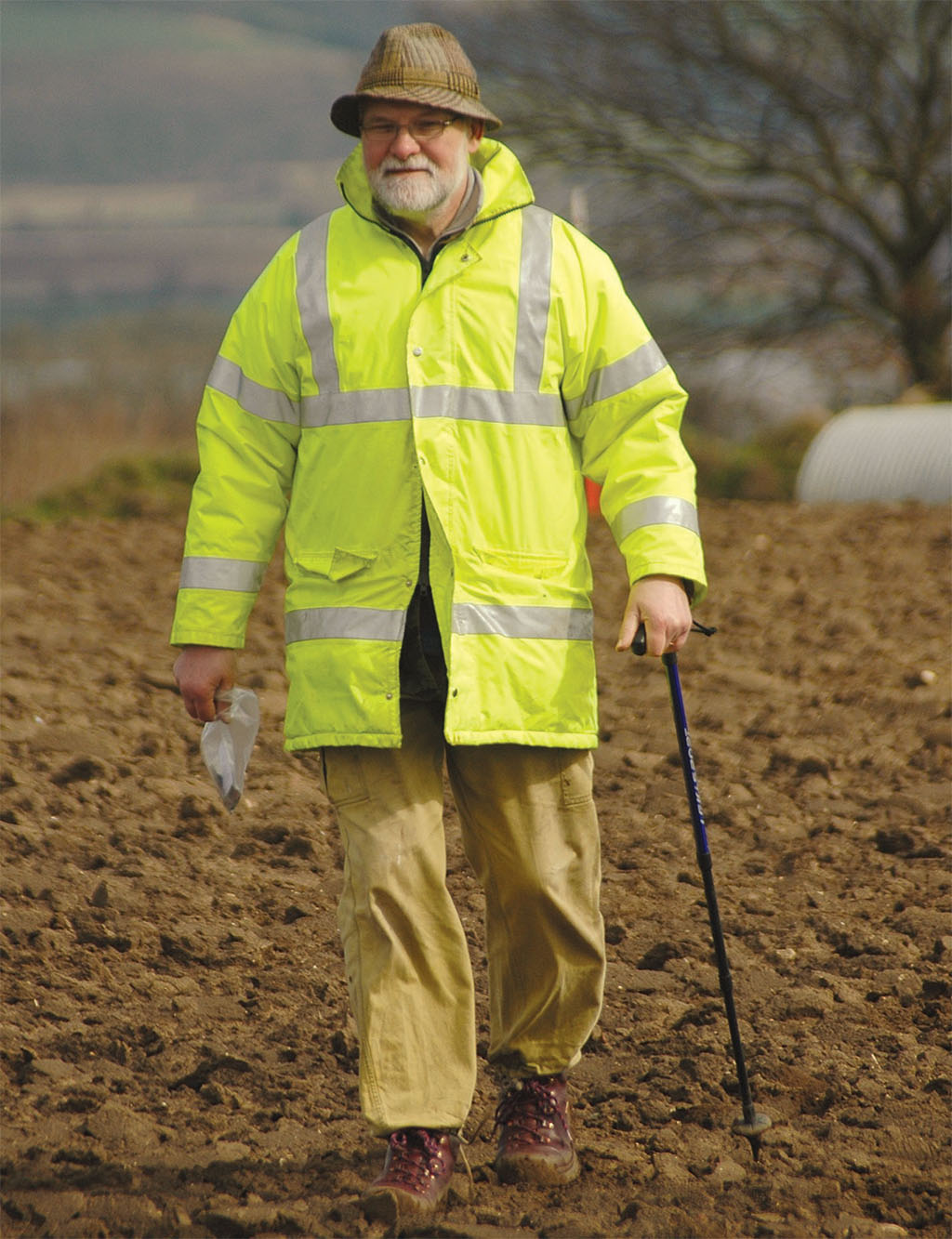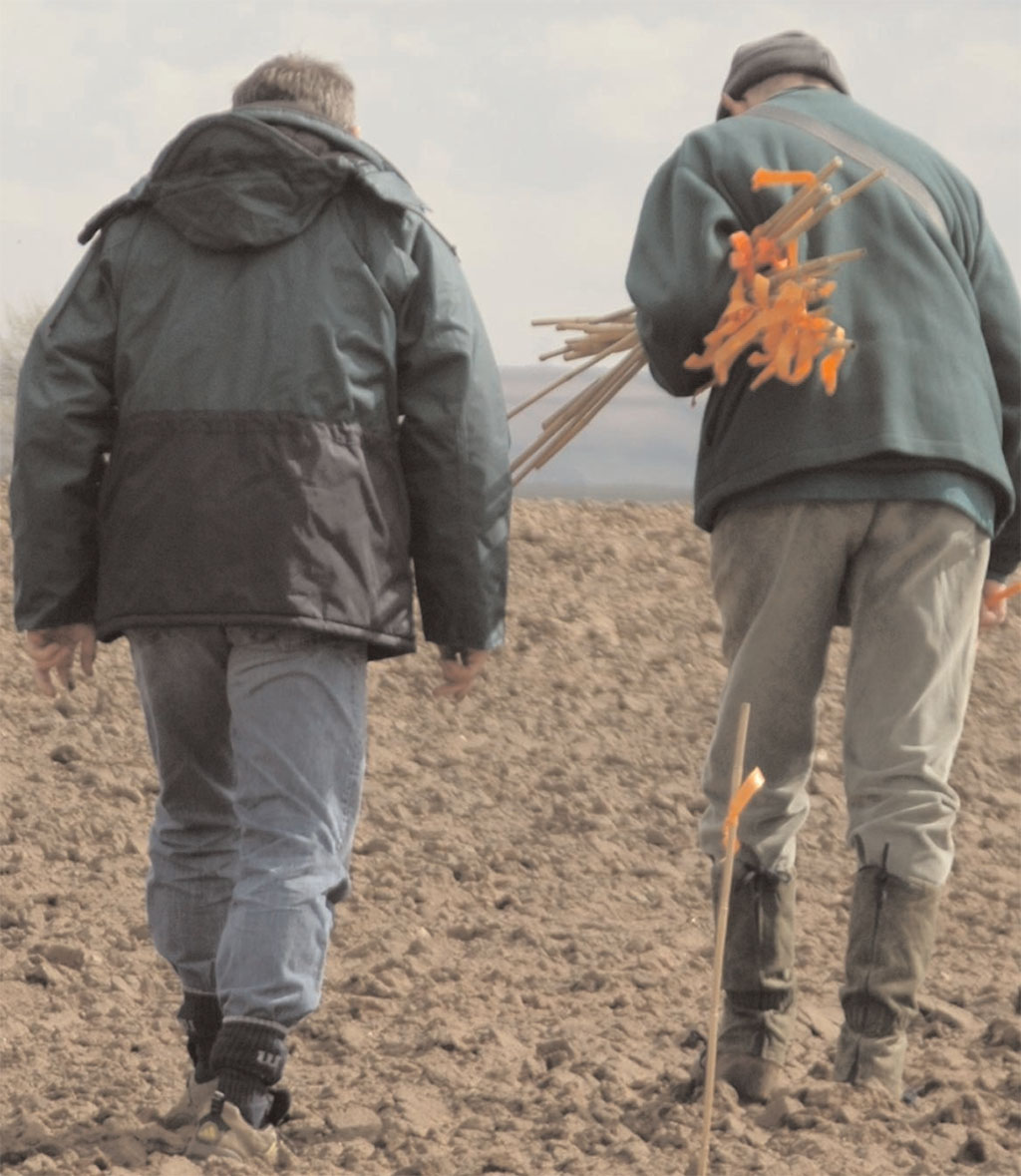
Fieldwalking in Alkborough British History: Just a Load of Garbage?
SOME TIME AFTER THE LAST ICE AGE, a hunter, stalking his prey along a coastal hillside, shot his flint-tipped arrow at his next meal—and missed. Despite his search, the arrow lay where it fell in the tall grasses. Four thousand years passed, and, far away, pyramids began to appear in the deserts of Egypt. Another thousand years would pass before the great circle of Stonehenge would rise on England’s Salisbury Plain. It would be nearly 8,000 years before the Romans arrived in Britain, and still the arrowhead lay where it had fallen. “Megalithic,” notes my companion, picking it off the ground. “Nice piece; he’ll have been sorry to lose that.”
Kevin Leahy is an archaeologist with the Lincolnshire County Council, and he is here to lead a team of volunteers from the Community Archaeology Project on a fieldwalking survey of this field near Alkborough, a quiet, remote part of North Lincolnshire bordering on the Humber Estuary. In the distance, traffic thunders across the Humber Bridge; but here skylarks sing above a field indistinguishable from the hundreds that cover the country.
I stare in awe at the evidence that people have lived around here for 10,000 years, but Leahy has already started across the ploughed surface toward the team gathering about 100 yards away. To me, on my first fieldwalking trip, it’s just a field full of stones. To Leahy, it’s a catalogue of history. As we walk, he keeps up a running commentary on the things he spots: “Roman grayware. Samian, that’s nice, we’ll mark that. Medieval. Ah, piece of clay pipe, must have been enjoying a smoke as he ploughed. Modern, about 200 years old or so.” I soon realize this is no ordinary field.
The Community Archaeology Project is one of several around the country set up through grants from the National Lottery to enable local people to become involved in discovering the past of their area. For the friendly bunch of volunteers I meet beside the project’s van it’s a chance to help research the history of their region. Like me, they’re all devoted fans of TV archaeology shows and eager to try it out for themselves. For the professional archaeologists, it’s a chance to carry out work that might otherwise not be funded—in this case into a possible Roman villa site believed to be somewhere under our feet.
[caption id="TimelineAD300_img1" align="aligncenter" width="1024"]

COURTESY OF TIM LYNCH
Leahy explains that the aim of today is to make a survey to find out what artifacts might be here and whether they might point to occupation during the Roman period. “Ploughing disturbs the evidence and brings it to the surface,” he explains. “Fieldwalking is noninvasive and allows us to plot what we find and where so we can narrow down the search when we come to dig.” He tells me that at one medieval site, finds were so concentrated that by plotting their positions, the street pattern of a long-vanished village could clearly be seen. We may be lucky here, too.
To aid mapping, the team lays out a grid pattern using bamboo canes, and then each of us is issued a plastic bag for our finds and allocated a strip of land to search. As a novice, I’m paired with one of the professional members of the team, Alison Williams. She explains what we are looking for. “We’ll mark any Roman or older finds where we find them and we’ll bag up all the later stuff. It’ll tell us a lot, but it’s not stuff from here.” I ask her how she knows. “Over the years, people have used fertilizer on this soil. Some of it has come from farmyard manure heaps, and later, when towns started to develop, farmers would go into town in the morning with their produce on their cart and come back at night loaded with night soil.” I look blank. “There was no sewerage [sewer systems] back then; you had to empty it somewhere, and here was the ideal place,” she says with a smile. “That’s right, you’re looking through the contents of several centuries of poo.” Broken pots and glass and pieces of broken tobacco pipes, they all ended up thrown into cess pits and manure piles and from there to here. Henry Ford once said that history is bunk. Archaeologists are the first to admit that their subject really is just a load of garbage.
As we set out, Alison shows me what to look for and examines my finds. “Modern,” she tells me, picking out a piece of pot covered in a rich dark brown glaze. Modern, to her, means only around 300 years old. As the search goes on, with her help I quickly learn to spot the different styles of pottery and glazing and become so absorbed that, like the rest of the team, I barely notice that this is a British spring day, and that means warm sunshine followed in rapid succession by rain, hail, bitterly cold winds and lightning. Still we plod on, looking to passing motorists as if we’ve just had a mass contact lens drop. Even as my back starts to ache, I find I can’t lift my eyes from the shards of prehistoric and Roman, medieval and Victorian pots lying side by side before me, the whole history of the land in a mosaic.
As we continue, most of these finds are placed in labeled plastic bags so that they can be logged later. Important finds are marked with canes and left so that Mike Hemblade, another member of the professional team, can plot the position exactly using a global positioning system. This creates a map of the site showing where the main finds are concentrated. This, along with aerial photography and ground-penetrating radar, will help to confirm where our villa stood. Today Mike is a busy man.
Breaking for lunch, the team is in high spirits. I find Leahy discussing a piece of Roman Samian ware pottery. Sometimes, he says, these were decorated with erotic scenes. At one site, he tells us: “We had a rather prim lady volunteer, washing this stuff as we found it. When she told me about it later, all she could say was, ‘The more I washed it, the filthier it got!’”
The team knew that the area was likely to be rich in finds. After all, one-fourth of all England’s rivers empty into the Humber, and it has been a major trading route for thousands of years, hence human activity has been continuous. But, even so, everyone is taken aback by the sheer volume of Roman finds. “I don’t think we’re in any doubt now that we’re in the right place,” Leahy says with a grin.
[caption id="TimelineAD300_img2" align="aligncenter" width="706"]

COURTESY OF TIM LYNCH
Lunch over, we set about laying out a new grid farther along the field. A shout goes up. Even before we have started, another arrowhead has been found, this one from the Bronze Age (circa 2500 BC). The afternoon produces an interesting harvest of history and, working alone now, I feel a special thrill to know that the pieces I have found were last held by someone 2,000 years ago. It’s an amazing feeling that somehow the past isn’t remote anymore; two millennia are reduced to me and a farmer, both seeing the same view from the same piece of land. He could never have imagined me, and I can barely picture what he must have been like.
Professionals call it “the archaeological imagination,” the ability to piece together evidence and tell the story. Accounts of excavations and searches are almost always filled with a sense of excitement and wonder and, for the first time, I get some idea of what it must have been like to make a big discovery. The media always like to compare archaeologists to Indiana Jones, but the reality is far from that. Golden goblets are all very nice, but they don’t have much to say about real people doing real things. Looking at a fragment of a plate, I can’t help thinking about a plate I broke at home last week. I wonder where that’ll be 2,000 years from now.
Community Archaeology Projects are run at several sites across the UK and offer the public the opportunity to become involved in surveys and fieldwork, as well as a program of study days and lectures.
For more information, contact The Council for British Archaeology, St. Mary’s House, 66 Bootham, York, YO30 7BZ, UK, (+44) (0) 1904 671417, www.britarch.ac.uk.
[caption id="TimelineAD300_img3" align="aligncenter" width="1024"]

COURTESY OF TIM LYNCH





Comments